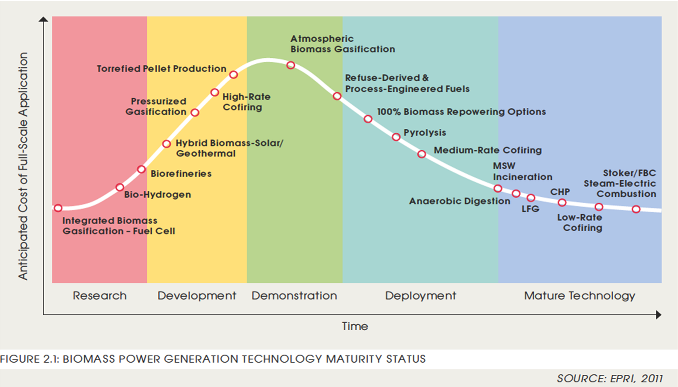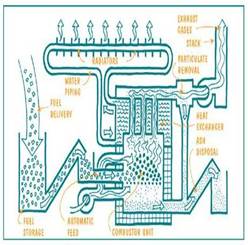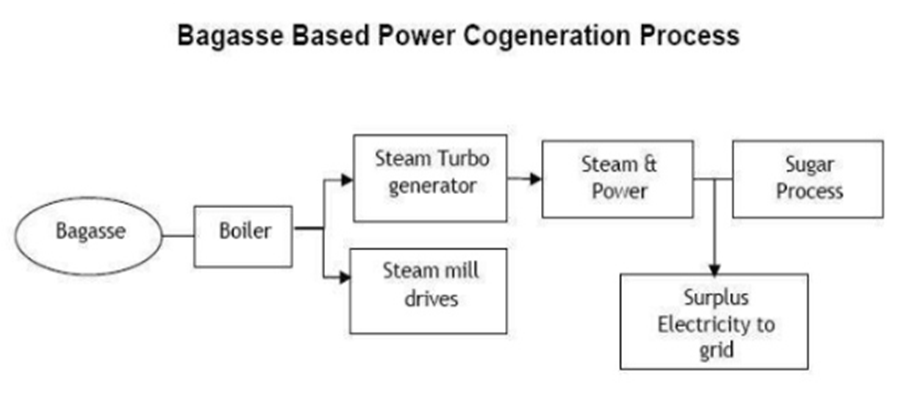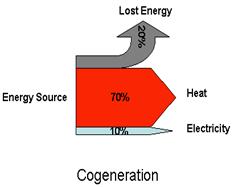Biomass Energy Technology
- Industrial Biomass Combustion
- Cogeneration
- Direct-Fired Gas Turbine Technology
- Co-Firing
- Gasification
Biomass Technology Maturity Status:
Source EPRI, 2011

Types of Gasifiers
- Pyrolysis
- Residential Fuels
Industrial Biomass Combustion

Combustion on large/industrial scale can burn many types of biomass fuel, including wood, agricultural residues, wood pulping liquor, municipal solid waste (MSW) and refuse-derived fuel. These in turn can result in several forms of useful energy for commercial or industrial uses like hot air, hot water, steam and electricity.
A furnace is the simplest combustion technology. In a furnace, biomass fuel burns in a combustion chamber, converting biomass into heat energy. As the biomass burns, hot gases are released. These hot gases contain about 85 percent of the fuel´s potential energy. Commercial and industrial facilities use furnaces for heat either directly or indirectly through a heat exchanger in the form of hot air or water.
A biomass-fired boiler is a more adaptable direct combustion technology because a boiler transfers the heat of combustion into steam. Steam can be used for electricity, mechanical energy or heat. Biomass boilers supply energy at low cost for many industrial and commercial uses.
A boiler´s steam output contains 60 to 85 percent of the potential energy in biomass fuel. The major types of biomass combustion boilers are pile burners, stationary or traveling grate combustors and fluidized-bed combustors.
Pile burners consist of cells, each having an upper and a lower combustion chamber. Biomass fuel burns on a grate in the lower chamber, releasing volatile gases. The gases burn in the upper (secondary) combustion chamber. Operators must shut down pile burners periodically to remove ash. Although capable of handling high-moisture fuels and fuels mixed with dirt, pile burners have become obsolete with the development of more efficient combustion designs with automated ash removal systems.
In a stationary or traveling grate combustor, an automatic feeder distributes the fuel onto a grate, where the fuel burns. Combustion air enters from below the grate. In the stationary grate design, ashes fall into a pit for collection. In contrast, a traveling grate system has a moving grate that drops the ash into a hopper.
Fluidized-bed combustors burn biomass fuel in a hot bed of granular material, such as sand. Injection of air into the bed creates turbulence resembling a boiling liquid. The turbulence distributes and suspends the fuel. This design increases heat transfer and allows for operating temperatures below 972° C (1700° F), reducing nitrogen oxide (NOx) emissions. Fluidized-bed combustors can handle high-ash fuels and agricultural biomass residue.
Conventional combustion equipment is not designed for burning agricultural residues. Straws and grasses contain potassium and sodium compounds. These compounds (called alkali) are present in all annual crops and crop residues and in the annual growth of trees and plants. During combustion, alkali combines with silica, which is also present in agricultural residues. This reaction causes slagging and fouling problems in conventional combustion equipment designed for burning wood at higher temperatures.
Volatile alkali lowers the fusion temperature of ash. In conventional combustion equipment having furnace gas exit temperatures above 1450° F, combustion of agricultural residue causes slagging and deposits on heat transfer surfaces. Specially designed boilers with lower furnace exit temperatures could reduce slagging and fouling from combustion of these fuels. Low-temperature gasification may be another method of using these fuels for efficient energy production while avoiding the slagging and fouling problems encountered in direct combustion.
Cogeneration


Biomass combustion facilities that produce electricity from steam-driven turbine-generators have a conversion efficiency of 17 to 25 percent. Using a boiler to produce both heat and electricity (cogeneration) improves overall system efficiency to as much as 85 percent. That is, cogeneration converts 85 percent of the fuel´s potential energy into useful energy in two forms: electricity and steam heat.
Two cogeneration arrangements, or cycles, are possible for combining electric power generation with industrial steam production. Steam can be used in an industrial process first and then routed through a turbine to generate electricity. This arrangement is called a bottoming cycle. In the alternate arrangement, steam from the boiler passes first through a turbine to produce electric power. The steam exhaust from the turbine is then used for industrial processes or for space and water heating. This arrangement is called a topping cycle. Of the two cogeneration arrangements, the topping cycle is more common.
Direct-Fired Gas Turbine Technology
The direct-fired gas turbine is another combustion technology for converting biomass to electricity. In this technology, fuel pretreatment reduces biomass to a particle size of less than 2 millimeters and a moisture content of less than 25 percent. Then the fuel is burned with compressed air. Cleanup of the combustion gas reduces particulate matter before the gas expands through the turbine stage. The turbine drives a generator to produce electricity.
Co-Firing
Co-firing biomass as a secondary fuel in a coal-burning power plant using high-sulfur coal could help reduce sulfur dioxide and nitrogen oxide emissions. Also, CO-firing decreases net carbon dioxide emissions from the power plant (if the biomass fuel comes from a sustainable source). CO-firing may require wood fuel preparation or boiler modifications to maintain boiler efficiency.
Gasification

Gasification is a thermochemical process that converts biomass into a combustible gas called producer gas. Producer gas contains carbon monoxide, hydrogen, water vapor, carbon dioxide, tar vapor and ash particles. Gasification produces a low-Btu or medium-Btu gas, depending on the process used.
Producer gas contains 70 percent to 80 percent of the energy originally present in the biomass feedstock. The gas can be burned directly for space heat or drying, or it can be burned in a boiler to produce steam. Medium-Btu producer gas can be converted into methanol, a liquid fuel. Electric power generation is possible by combining a gasifier with a gas turbine or fuel cell.
Filters and gas-scrubbers remove tars and particulate matter from producer gas. The clean gas is suitable for use in an internal combustion engine, gas turbine or other application requiring a high-quality gas. Use of producer gas in a fuel cell requires reforming clean gas into hydrogen ions and carbon monoxide. Fuel cells produce electricity and thermal energy from hydrogen through an electrochemical conversion process.
Gasification technology is in the development stage. There are a few demonstration projects that use varied gasifier designs and plant configurations. However, pretreatment of biomass feedstock is generally the first step in gasification. Pretreatment involves drying, pulverizing and screening. Optimal gasification requires dry fuels of uniform size, with a moisture content no higher than 15 percent to 20 percent.
Biomass gasification is a two-stage process. In the first stage, called pyrolysis, heat vaporizes the volatile components of biomass in the absence of air at temperatures ranging from 450° to 600° C (842° to 1112° F). Pyrolysis vapor consists of carbon monoxide, hydrogen, methane, volatile tars, carbon dioxide and water. The residue, about 10 percent to 25 percent of the original fuel mass, is charcoal.
The final stage of gasification is called char conversion. This occurs at temperatures of 700° to 1200° C (1292° to 2192° F). The charcoal residue from the pyrolysis stage reacts with oxygen, producing carbon monoxide.
In the process of combustion, both stages of gasification occur. When wood burns, the heat of combustion produces pyrolytic vapors. Some gasification of these vapors also occurs. In combustion, however, the pyrolytic vapors are immediately burned at temperatures in the range of 1500° to 2000° C. In contrast, the process of gasification is controlled, allowing the volatile gases to be extracted at a lower temperature before combustion.
Types of Gasifiers
There are three principal types of gasification systems: updraft, downdraft and fluidized-bed. In an updraft (or "counterflow") gasifier, the biomass fuel enters the top of the reaction chamber while steam and air (or oxygen) enter from below a grate. The fuel flows downward, and upflowing hot gases pyrolyze it. Some of the resulting charcoal residue falls to the grate, where it burns, producing heat and giving off carbon dioxide (CO2) and water vapor (H2O). The CO2 and H2O react with other charcoal particles, producing carbon monoxide (CO) and hydrogen (H2) gases. The gases exit from the top of the chamber. Ashes fall through the grate.
The updraft design is relatively simple and can handle biomass fuels with high ash and moisture content. However, the producer gas contains 10 percent to 20 percent volatile oils (tar), making the gas unsuitable for use in engines or gas turbines.
Successful operation of a downdraft (or "co-flow") gasifier requires drying the biomass fuel to a moisture content of less than 20 percent. Fuel and air (or oxygen) enter the top of the reaction chamber. Downflowing fuel particles ignite, burning intensely and leaving a charcoal residue. The charcoal (which is about 5 to 15 percent of the original fuel mass) then reacts with the combustion gases, producing CO and H2 gases. These gases flow down and exit from the chamber below a grate. The producer gas leaving the gasifier is at a high temperature (around 700° C). Combustion ash falls through the grate. The advantage of the downdraft design is the very low tar content of the producer gas.
A fluidized-bed gasifier typically contains a bed of inert granular particles (usually silica or ceramic). Biomass fuel, reduced to particle size, enters at the bottom of the gasification chamber. A high velocity flow of air from below forces the fuel upward through the bed of heated particles. The heated bed is at a temperature sufficient to partially burn and gasify the fuel. The processes of pyrolysis and char conversion occur throughout the bed. Although fluidized-bed gasifiers can handle a wider range of biomass fuels, the fuel particles must be less than 10 centimeters in length and must have no more than 65-percent moisture content. The fluidized-bed design produces a gas with low tar content but a higher level of particulate compared with fixed-bed designs.
If the gasifier is pressurized, it produces gas at a pressure suitable for electric power generation using a gas turbine. High-pressure fuel-feed systems are in the development stage. Hot gas cleanup technology is also under development. Hot gas cleanup removes tars, chars and volatile alkalis to improve system efficiency.
Progress in the development of biomass-fired gas turbine technology may include combined-cycle electricity generation. In a combined-cycle facility, a gas-fired turbine generator produces primary power. Waste heat from the turbine exhaust is used to produce high-pressure steam, which then drives a steam turbine to generate secondary power.
Pyrolysis
In a process known as fast pyrolysis, fine, low-moisture biomass fuel particles are heated rapidly to temperatures in the range of 450° to 550° C (842° to 1022° F), resulting in liquid pyrolysis oil but very little gas. The oil produced in fast pyrolysis is 60 percent to 75 percent of the original fuel mass. It can be used as a synthetic fuel oil. Recent analysis suggests, however, that pyrolytic oils are more valuable as chemicals for use in making other products.
Residential Fuels
Many Oregonians convert biomass to useful energy in their homes by burning wood in a fireplace or woodstove. Newer forms of residential biomass fuels are pellets and manufactured logs. Charcoal briquettes used in backyard barbecues are another common residential biomass fuel.
Pellets, briquettes and manufactured logs are different forms of densified fuels. These biomass fuels are made from wood wastes, waste paper and cardboard, and agricultural residues. The first steps in densification are reducing the biomass feedstock to particles ¼ inch or less in diameter and drying the feedstock to a moisture content of 10 to 15 percent. Mechanical compression or extrusion then forms the material into a product that has less than one-third of the feedstock's original volume.
Heat and compression soften the lignin bonds in the biomass, so that the final product maintains its densified shape. Residual moisture in the feedstock turns to steam during compression and helps lubricate the compression die. Some densification processes use additional binders or lubricants. Different machines produce densified fuel products of different shapes and sizes, ranging from pea-sized pellets to logs 12 inches long and 6 inches in diameter.
Modern pellet stoves are efficient home heating appliances. A conventional fireplace is less than 10-percent efficient at delivering heat to a home. In contrast, average pellet stove efficiency is better than 55-percent.
The use of pellet stoves in place of conventional wood stoves reduces the amount of particulate matter in the air. This is especially beneficial in areas where wood smoke from home wood-heating is a major component of local air pollution. In pellet stoves, particulate matter emissions are as much as 90-percent lower than emissions from conventional wood stoves.
MSW incineration should be distinguished from landfill methane. Using methane captured from landfills to fuel power plants is far superior to allowing the methane and other air toxics generated by landfills to escape into the atmosphere (where the methane has a global warming potential 21 times that of carbon dioxide) or simply flaring the gas.
Biomass currently provides about 2% of the electricity produced in the U.S., and, according to the American Biomass Association, it could easily supply 20%. As a result of the available land and agricultural infrastructure this country already has, biomass could conceivably replace all of the power that nuclear plants generate and do so in a sustainable fashion.
Yes. If biomass is cultivated and harvested in a way that allows regrowth without depleting nutrient and water resources, it is a renewable resource that can be used to generate energy on demand, with little or no net contributions to global greenhouse gas emissions.
People have used biomass for heating and cooking for thousands of years. With today’s technology, plant materials can be used to generate electricity, heat, or liquid fuels for motor vehicles that have substantially lower environmental impacts than traditional fossil fuels.
Email your enquires to contact@energy-guru.com
